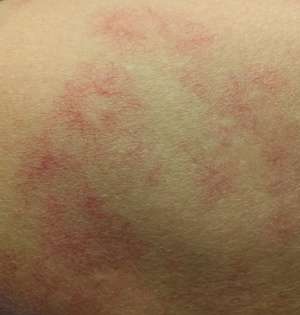Acute alcoholic hepatitis
Background
Acute alcoholic hepatitis is inflammatory liver disease secondary to alcohol use.
- Spectrum from hepatic steatosis to alcoholic hepatitis to cirrhosis
- History of (usually chronic) alcohol abuse (~80 grams of ethanol daily for 5 years)
- Ranges from subclinical cases to severe multisystem dysfunction
Clinical Features

Spider angioma
Symptoms
- Abdominal pain
- Nausea and vomiting
- Weight loss / fatigue / anorexia
Signs
- RUQ tenderness
- Jaundice
- Fever
- Hepatomegaly
- Ascites
- Encephalopathy
- Spider angioma
- GI bleed/varices
- Malnutrition
- Symptoms of alcohol withdrawal
Cirrhosis is found in 50-60% of cases of alcoholic hepatitis[1]
Differential Diagnosis
- Alcoholic pancreatitis
- Gallstones
- Budd-Chiari syndrome
- Viral hepatitis
- Drug-induced hepatitis
Evaluation
Work Up
Labs
- CBC
- Leukocytosis with elevated ANC
- Chemistry including magnesium and phosphate
- LFTs
- Very high elevations possibly more suggestive of viral or drug-induced hepatitis
- Elevated AST/ALT (characteristically >2:1 and < 500 IU/L)
- GGT alone is less reliable (low sensitivity and specificity)[2]
- Coagulation factors
- Elevated PT/INR
- Lipase if suspect pancreatitis
- Consider viral hepatitis panel
Imaging
- Consider transabdominal ultrasound if concern for:
- Biliary obstruction
- Budd-Chiari syndrome
- Hepatic or biliary neoplasms
Evaluation
- Diagnosis is difficult and relies on a good history[3]
- History of significant alcohol intake
- Clinical evidence of liver disease
- Supporting laboratory abnormalities
- May be nondiagnostic in patients with mild disease or early cirrhosis
Management
- Control of withdrawal symptoms
- Nutritional support for malnutrition: especially thiamine, folate, pyridoxine, magnesium, phosphate, glucose, and protein
High risk, severe cases
- Steroids
- Pentoxifylline - may not provide any added benefit[4]
Disposition
- Discharge
- Mild disease/low risk
- Nutritional assessment and intervention
- Discuss alcohol use and recommend strict abstinence
- Admit
- High risk defined as MDF ≥ 32, MELD ≥ 18, or presence of hepatic encephalopathy
Prognosis
See Also
External Links
References
- Basra, Gurjot,et. al. "Symptoms and Signs of Acute Alcoholic Hepatitis." World J Hepatol. 2011 May 27; 3(5): 118–120.
- O'Shea RS, Dasarathy S, McCullough AJ (2010) Alcoholic liver disease. Hepatology 51: 307–328. doi: 10.1002/hep.23258
- O'Shea RS, Dasarathy S, McCullough AJ (2010) Alcoholic liver disease. Hepatology 51: 307–328. doi: 10.1002/hep.23258
- Mathurin P, Louvet A, Duhamel A, et al. Prednisolone with vs without pentoxifylline and survival of patients with severe alcoholic hepatitis: a randomized clinical trial. JAMA. 2013;310(10):1033-41.
- O'Shea RS, Dasarathy S, McCullough AJ (2010) Alcoholic liver disease. Hepatology 51: 307–328. doi: 10.1002/hep.23258
This article is issued from
Wikem.
The text is licensed under Creative
Commons - Attribution - Sharealike.
Additional terms may apply for the media files.